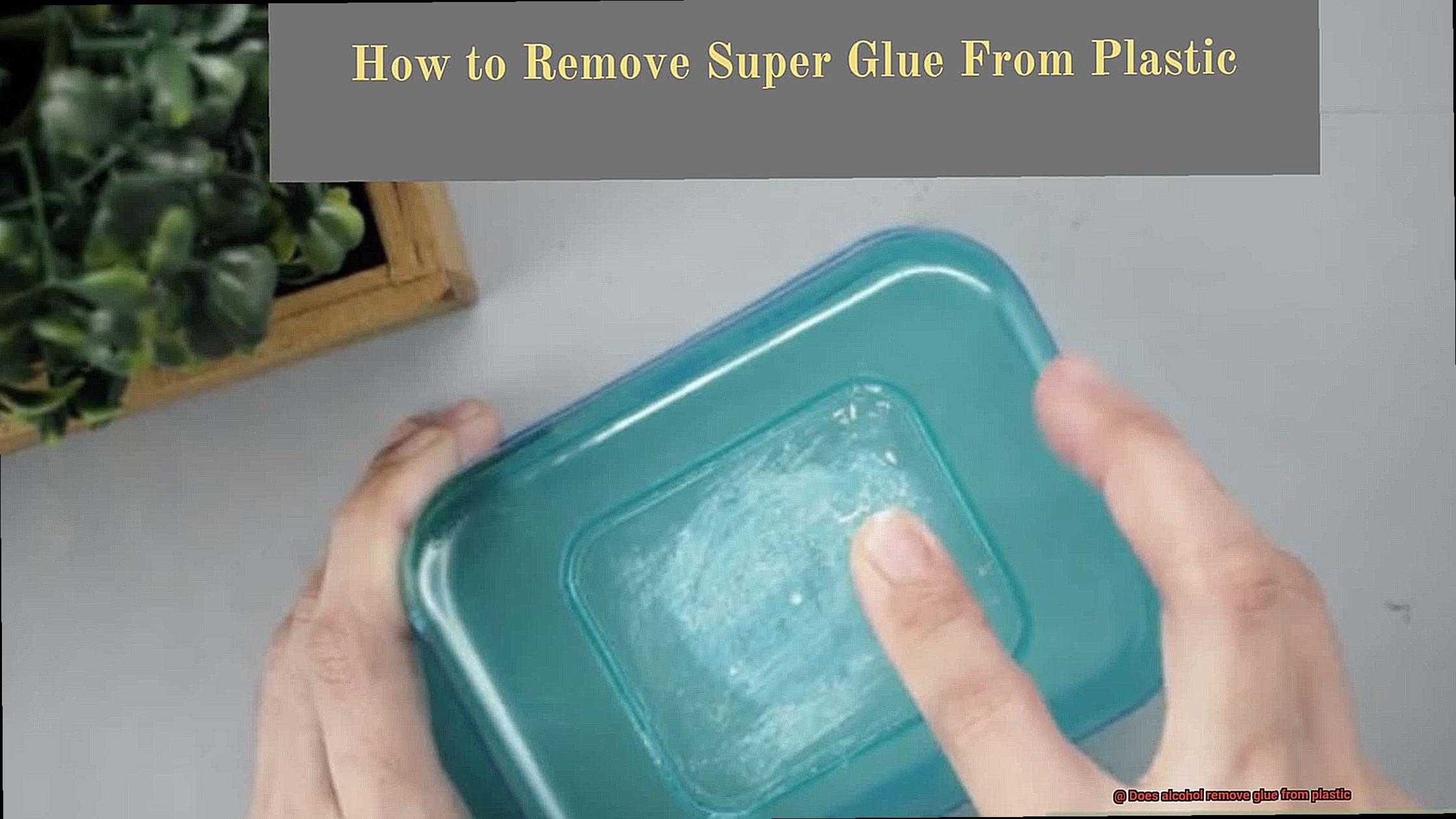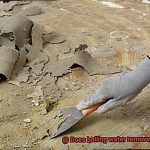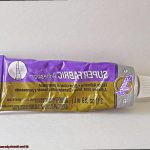Ever been stuck with a plastic item covered in stubborn glue residue? We’ve all fought that losing battle, desperately trying to rid our beloved possessions of those sticky remnants. But fret not, my friends, because today we’re about to uncover a secret weapon hiding in your liquor cabinet: alcohol.
Imagine this: You’ve just snagged a shiny new gadget or a charming piece of home decor, only to discover that removing the price sticker has left an unsightly mess. Or perhaps you accidentally spilled glue on a plastic surface during a DIY project and now you’re on the hunt for a reliable fix. That’s when alcohol steps onto the scene.
Main points:
- The enchanting power of alcohol: Forget those traditional glue removers; alcohol is like magic when it comes to banishing glue from plastic surfaces. With its chemical composition, particularly isopropyl or rubbing alcohol, it can break down the adhesive properties of most glues, making them easy peasy to remove.
- The technique at play: Applying alcohol directly or using a cotton ball or cloth allows it to infiltrate the glue and weaken its grip. After just a few moments of alcohol’s active involvement, gently rubbing or scraping away the residue becomes as effortless as waving goodbye.
- A word of caution: While alcohol is a trusty ally in your war against glue, exercise caution when using it on certain types of plastic. Always do a spot test on an inconspicuous area to ensure there are no negative reactions. Delicate or painted plastics may require alternative methods to avoid any damage or unsightly discoloration.
Types of Glue that can be Removed by Alcohol
Contents
- 1 Types of Glue that can be Removed by Alcohol
- 2 Factors to Consider Before Using Alcohol to Remove Glue from Plastic
- 3 Testing the Plastic Surface for Damage or Discoloration
- 4 Effectiveness of Alcohol in Removing Different Types of Glue
- 5 How to Use Alcohol as a Glue Remover
- 6 Additional Techniques for Removing Difficult Adhesives
- 7 Commercial Adhesive Removers Available on the Market
- 8 Conclusion
When it comes to freeing plastic surfaces from the clutches of glue, alcohol emerges as a formidable weapon. However, not all glues are susceptible to its powers. In this article, we will delve into the different types of glue that can be effectively removed by alcohol and provide essential insights to ensure a successful adhesive liberation.
Adhesive Glue:
Craft projects and material bonding often call for adhesive glue, which can be easily conquered by alcohol. By breaking down the adhesive properties, alcohol facilitates the removal of this glue from plastic surfaces. Begin by applying a small quantity of rubbing alcohol to a cloth or cotton swab and gently rub the glue until it dissolves completely. Remember to test the alcohol on an inconspicuous area before proceeding to avoid any potential damage.
Super Glue:
Known for its unyielding grip, super glue can be tamed by the power of alcohol. Isopropyl alcohol, commonly referred to as rubbing alcohol, weakens its hold on plastic surfaces. To vanquish this formidable foe, saturate a cloth or cotton swab with rubbing alcohol and delicately massage the super glue until it loosens its grip. Once weakened, it can be peeled off or scraped away with ease.
Industrial Glue:
Alcohol’s potency extends to certain types of industrial glues such as epoxy and cyanoacrylate, commonly used in manufacturing and construction settings. As a solvent, alcohol disintegrates the chemical bonds of these strong glues. To initiate their demise, apply rubbing alcohol to a cloth or cotton swab and gently rub the glue until it dissolves into oblivion.
White Craft Glue:
Water-based white craft glue or school glue is no match for the dissolving power of alcohol. While it may require more effort and repeated applications, alcohol can effectively dissolve this type of glue from plastic surfaces. However, exercise caution and conduct a patch test on a small area to ensure that no damage occurs during the removal process.
Adhesive Tapes:
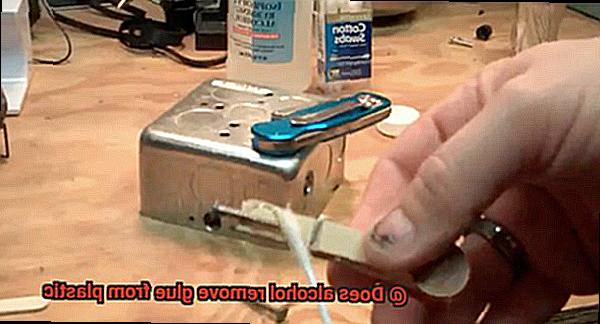
Even adhesive tapes, such as double-sided or adhesive foam tape, fall under the dominion of alcohol. To liberate plastic surfaces from their sticky residue, apply a small amount of rubbing alcohol to the affected area and allow it to soak for a few minutes. Then, with the aid of a plastic scraper or your trusty fingernail, gently scrape off the softened residue. Repeat the process until the surface is impeccably clean.
Caution and Alternatives:
While alcohol is an effective solution for various glues, it may not conquer all adhesive adversaries. Epoxy glues, in particular, often exhibit resistance to solvents like alcohol. In such cases, alternative methods or specialized adhesive removers tailored for epoxy glue removal may be necessary.
Factors to Consider Before Using Alcohol to Remove Glue from Plastic
Factor #1: The Type of Glue
Glues can be as unique as snowflakes, each with its own chemical composition. This means that not all glues will respond equally to alcohol. While craft glue or adhesive tapes may surrender to alcohol’s dissolving powers, super glue or cyanoacrylate adhesive can be resistant. Before you reach for that bottle of alcohol, identify the type of glue you’re dealing with to determine its compatibility.
Factor #2: The Type of Plastic
Just as glues have their idiosyncrasies, plastics do too. Some plastics may react negatively when exposed to alcohol, leading to discoloration or even damage. To avoid any unfortunate mishaps, take a moment to check the plastic code on your item or consult the manufacturer’s instructions for guidance on using alcohol-based products. Trust me, you wouldn’t want your cherished plastic possessions transformed into psychedelic artwork.
Factor #3: Surface Sensitivity
Once you’ve determined that both your glue and plastic can peacefully coexist with alcohol, it’s time to consider the sensitivity of the plastic surface itself. If your plastic item is delicate or prone to scratches, using alcohol might not be the best option. Certain surfaces can suffer from abrasions or dullness when exposed to alcohol. To play it safe, test a small, inconspicuous area first to ensure the alcohol won’t leave any unwelcome marks on your beloved plastic possessions.
Testing the Plastic Surface for Damage or Discoloration
When it comes to removing glue from plastic surfaces, caution is key. You wouldn’t want your cherished possessions to suffer from a misguided attempt at adhesive removal. In this section, we will explore how to test the plastic surface for any potential damage or discoloration before embarking on glue removal. Let’s ensure the safety and preservation of your beloved items.
Identifying the Type of Plastic:
Before attempting any adhesive removal technique, it is crucial to identify the type of plastic you are working with. Different plastics have varying chemical compositions that may react differently to solvents like alcohol. Common types include polyethylene (PE), polypropylene (PP), polyvinyl chloride (PVC), and polystyrene (PS). Each type possesses unique properties that can influence the effectiveness of alcohol in removing glue.
Conducting the Test:
To begin, select a small, inconspicuous area on the plastic surface that won’t be easily noticeable. Thoroughly clean this area with mild soap and water, ensuring it is free from any dust, dirt, or oils that could interfere with the test results. Once clean and dry, proceed with caution.
Take a soft cloth or cotton ball and apply a small amount of rubbing alcohol onto it. Gently rub the alcohol-soaked cloth on the selected area using light pressure and circular motions. Observe any changes in the plastic surface during this process. Look out for signs of damage such as scratching, dulling, or melting. Additionally, pay attention to any discoloration that may occur due to the interaction between alcohol and the plastic material.
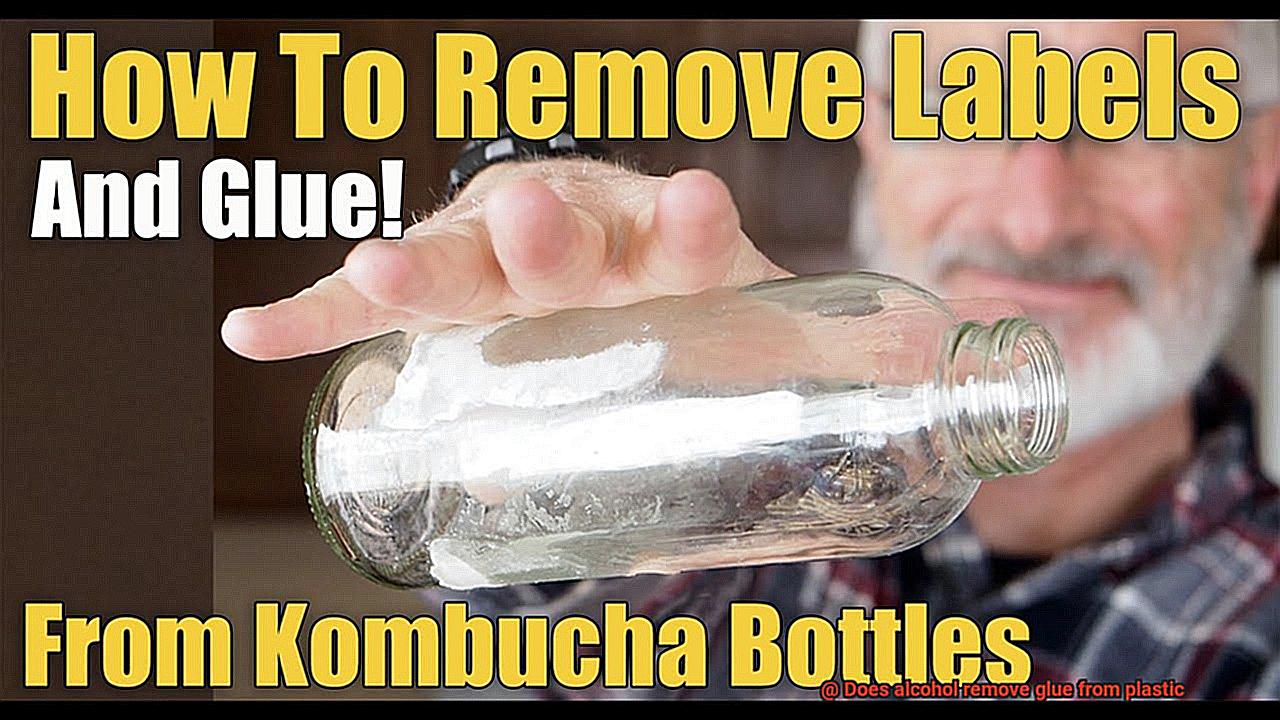
Interpreting the Results:
After a brief rubbing session, closely examine the test area. If no visible signs of damage or discoloration are apparent, it is a positive indication that alcohol may be safe to use for glue removal on that particular plastic surface. However, remember that this test serves as a preliminary assessment. It is still recommended to proceed with caution and conduct a small-scale test on an inconspicuous area before applying alcohol to larger adhesive-covered portions.
Effectiveness of Alcohol in Removing Different Types of Glue
Fear not. I’m here to share expert insights on how alcohol can be your saving grace. When it comes to removing different types of glue, alcohol, specifically isopropyl or rubbing alcohol, possesses extraordinary powers. So, let’s delve deeper into the effectiveness of alcohol in tackling this sticky predicament.
Alcohol: The Glue Dissolver Extraordinaire:
Alcohol, particularly the mighty isopropyl or rubbing alcohol, emerges as a superhero in the realm of glue removal. Its remarkable solvent properties allow it to break down the adhesive bonds present in certain glues, rendering them more manageable to eliminate from plastic surfaces. However, exercise caution before proceeding and conduct a small patch test on the plastic surface to avoid any unforeseen consequences.
Decoding the Plastic Puzzle:
The world of plastics is a complex labyrinth, with each type possessing its own unique characteristics. Some plastics are delicate and prone to damage or discoloration upon contact with alcohol. Therefore, it becomes imperative to identify the specific type of plastic you are dealing with before employing alcohol as a glue remover. By conducting a small test on an inconspicuous area, you can safeguard against potential plastic disasters.
Glue Types and Alcohol’s Unyielding Effectiveness:
Glues come in diverse formulations, and their reaction to alcohol can manifest in various ways. Alcohol works like an enchanting elixir on glues that readily dissolve in its chemical makeup. Notable examples include super glue or specific adhesive tapes that succumb to the power of alcohol effortlessly. However, formidable foes such as epoxy or silicone-based adhesives may require additional techniques for complete eradication.
When Alcohol Calls for Reinforcements:
Occasionally, alcohol alone may not be enough to triumph over the glue battle. In such instances, it is time to bring out the heavy artillery. Employing a gentle scraping tool, such as a plastic scraper, or utilizing a cloth soaked in warm soapy water can aid in loosening the adhesive. Exercise caution throughout this process to prevent any inadvertent damage to the plastic surface.
Commercial Adhesive Removers: Alcohol’s Ultimate Sidekick:
If the glue stubbornly clings on, fret not. The market offers an array of commercial adhesive removers designed specifically to combat various types of glue on different surfaces, including plastic. These extraordinary products often yield superior results when compared to alcohol alone. Simply follow the instructions provided and let these prodigious solutions work their magic.
How to Use Alcohol as a Glue Remover
You accidentally spill glue on your beloved plastic item, leaving behind an unsightly mess. Fear not. The solution lies in the power of alcohol, a versatile adhesive remover that can effortlessly dissolve glue and restore your plastic surface to its former glory. In this comprehensive guide, we will walk you through the step-by-step process of using alcohol as a glue remover on plastic surfaces. So, let’s dive in and learn how to bid farewell to sticky situations.
Step 1: Test the Waters
Before embarking on your glue-removing journey, it’s crucial to conduct a small-scale test. Apply a touch of alcohol on an inconspicuous area of the plastic surface to ensure compatibility and avoid any potential damage or discoloration.
Step 2: Alcohol Application
Once you’ve received the green light from your compatibility test, it’s time to unleash the power of alcohol on the pesky glue. Equip yourself with a clean cloth or sponge and generously soak it with isopropyl alcohol. Gently dab the cloth onto the glue-covered area, ensuring every inch is thoroughly saturated. Exercise caution and refrain from vigorous rubbing that could harm the plastic.
Step 3: The Magic Unfolds
Now, give the alcohol some time to work its magic. Allow it to permeate the glue for several minutes, patiently dissolving the adhesive bonds that hold it in place.
Step 4: Scraping Away with Finesse
Once the alcohol has diligently softened the glue, it’s time for finesse. Armed with a trusty plastic scraper or a gentle-bristled brush, delicately scrape away the loosened glue. Exercise utmost care to prevent any scratches or harm to the delicate plastic surface.
Step 5: Persistence Pays Off
For stubborn or particularly tenacious glue, persistence is key. If remnants persist after your initial scraping efforts, don’t despair. Simply repeat the process by reapplying alcohol and allowing it to sit for a few more minutes. This will further loosen the glue, making it easier to remove.
Step 6: Cleanse and Dry
With the glue vanquished, it’s time to cleanse and restore your plastic surface. Employ a mild soap or detergent mixed with water to thoroughly clean away any remaining traces of alcohol residue. Rinse diligently and ensure the surface is completely dry before relishing in your victorious glue-removal triumph.
Additional Techniques for Removing Difficult Adhesives
In our previous quest, we uncovered the enchanting abilities of alcohol in defeating adhesive foes on plastic surfaces. But what if you confront a truly indomitable adhesive, one that refuses to yield? Fear not, fellow warriors of stickiness. In this next chapter, we delve into the realm of additional techniques that will empower you to conquer these formidable challenges. Brace yourself as we arm ourselves with heat, oil, acetone, and more in our quest to vanquish difficult adhesives on plastic surfaces.
Harness the Fiery Fury: Heat as a Weapon
When faced with tenacious adhesive bonds, heat becomes your secret ally. By applying controlled heat to the adhesive, you can soften its grip, rendering it easier to vanquish. Equip yourself with a hairdryer or a heat gun on a low setting. Be cautious and wield your heat wisely, avoiding excessive temperatures that could potentially harm the plastic surface.
Oil and Lubricants: The Mighty Dissolvers
Sometimes, all that is needed is a touch of lubrication to dissolve those stubborn adhesives. Enter the heroes of this tale: oils like vegetable oil or baby oil. Smear a small amount onto the adhesive, granting it time to work its magic for a few minutes. Then, armed with a gentle scrubbing instrument like a soft cloth or sponge, witness the adhesive’s resistance crumble before your eyes.
The Potent Elixir: Acetone’s Power
For those seeking an extra punch against formidable adhesives, acetone emerges as your trusted ally. As a mighty solvent, acetone can effectively dissolve many types of adhesives. However, tread carefully as certain plastic surfaces may prove vulnerable to acetone’s strength. Always conduct a test on a small area beforehand to ensure its power won’t inflict harm.
Commercial Adhesive Removers: Unleashing the Titans
These potent concoctions are meticulously crafted to dismantle and eliminate adhesives from various surfaces, including plastic. Follow their instructions with utmost care and test them on a small area before unleashing them fully. With the right elixir, even the most unyielding adhesive shall meet its defeat.
Commercial Adhesive Removers Available on the Market
Commercial adhesive removers come in various forms, from liquids to sprays, gels to wipes, allowing you to choose the most convenient option for your needs. They are crafted with precision, ready to take on the sticky foes that dare to bond with plastic surfaces.
One mighty contender in the world of adhesive removers is acetone-based. This warrior wields the power of a powerful solvent that can dissolve many types of adhesives, even those that cling to plastic surfaces. However, be cautious, for certain plastics may fall victim to its strength. Always test it on a small area before unleashing its power upon the entire surface.
But fear not, for there are safer alternatives that can still pack a punch. Enter the citrus-based adhesive removers, crafted with natural extracts and oils derived from our fruity friends. These gentle yet potent solutions work their magic by breaking down and dissolving adhesives without causing harm to most plastic surfaces. Plus, they offer the added bonus of a pleasant scent, making your adhesive-removing experience all the more delightful.
For those sticky residues left behind by tape or labels, specialized adhesive removers have been crafted just for you. These heroes take the form of gels or sprays and excel in loosening and dissolving that stubborn residue. With their help, you can bid farewell to the remnants of adhesive without leaving a trace of damage on the plastic surface.
When choosing your trusty adhesive remover, consider the type of adhesive you’re up against and the plastic surface you’re working with. Some removers may be more effective on certain adhesives or plastics than others, so tread carefully and read product labels and reviews to find the perfect match for your quest.
Remember, even the mightiest of adhesive removers require your guidance. Follow the instructions provided by the manufacturer, applying the remover to a clean cloth or sponge and gently rubbing it onto the adhesive until it begins to dissolve. Patience may be necessary as you allow the remover to work its magic, penetrating deep into the adhesive’s stronghold before attempting to remove it.
gx5NxButYMM” >
Conclusion
In conclusion, alcohol can indeed be effective in removing glue from plastic.
Its chemical properties break down the adhesive bonds, allowing you to easily peel off the sticky residue. Whether it’s a stubborn sticker on a plastic bottle or an accidental glue spill on your favorite toy, a simple application of alcohol can save the day.
Just grab a cotton ball or cloth, soak it in rubbing alcohol or vodka, and gently rub away the glue until it disappears. Remember to test it on a small, inconspicuous area first to ensure it doesn’t damage the plastic surface.
So, next time you find yourself dealing with an unwanted adhesive mess, reach for that trusty bottle of alcohol and watch as the glue magically dissolves away.

